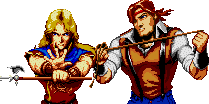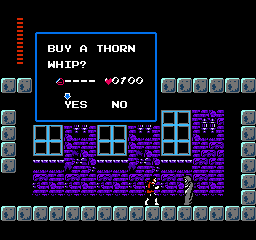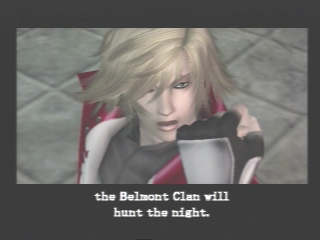
![]() Heroic Evolution
Heroic Evolution ![]()

According to the noted history of the series, the Belmont family and its bloodline have faced their destiny in destroying the Count and foiling his plans for over eight hundred years, a campaign that stretches as far back as the 11th century. The subjects at hand: What is the true lineage of the heroes? How did the family evolve over that one-thousand-year period? Where do those other heroes (such as Sypha, Alucard, Maxim Kischine and Eric Lecarde) fit in, both within the frame of the story and through the extroverted activities that go into making the games? How do differences between the Japanese and American games affect conditions of change? I'll attempt to study and answer these questions over the course of the following six pages. To zip to the chapter of your choice, click any of the links atop each page.
The Beginning | Dracula Arrives | Warrior Chromosomes | Absence of Surname | Full Circle | The Family Tree
|
|
The
Beginning
|
|
 Over
its twenty-year-plus history, control of the Castlevania series has
found itself in the hands of many different divisions and teams within Konami's
infrastructure--this opposed to franchises like Super Mario Bros.,
The Legend of Zelda and Mega Man, which have always progressed
and blossomed under the vision of single men. As a result of this constant
shuffling, the developers have been inadvertently adept at providing the series
a certain intrigue; thanks to their failure to fully explore the implications
and consequences of certain titles, the consumer has been left with lingering
questions, seeming contradictions at every turn, and cliffhangers whose results
are never bore, leaving perhaps too much to the imagination. It's not
so much that you can't wait to purchase the next game based on its content--it's
that you're anxious to discover the new storyline connections and unexpected
life directions taken by popular heroes who may make cameos. What
they haven't been good at, in taking this path of game-making, is consistency
in regard to recurrences and tenets that are supposed to be canon;
we get the
proposed storyline that "Dracula rises every one hundred years"
only to be greeted by a small number of Belmont representatives, but then--in
examining the twenty-plus titles, original and remake alike--we're presented
fourteen relevant stories of Dracula-thwarting heroism that stretch
out over a period of approximately one thousand years, an equation
that for series veterans is a mathematical boggle.
Over
its twenty-year-plus history, control of the Castlevania series has
found itself in the hands of many different divisions and teams within Konami's
infrastructure--this opposed to franchises like Super Mario Bros.,
The Legend of Zelda and Mega Man, which have always progressed
and blossomed under the vision of single men. As a result of this constant
shuffling, the developers have been inadvertently adept at providing the series
a certain intrigue; thanks to their failure to fully explore the implications
and consequences of certain titles, the consumer has been left with lingering
questions, seeming contradictions at every turn, and cliffhangers whose results
are never bore, leaving perhaps too much to the imagination. It's not
so much that you can't wait to purchase the next game based on its content--it's
that you're anxious to discover the new storyline connections and unexpected
life directions taken by popular heroes who may make cameos. What
they haven't been good at, in taking this path of game-making, is consistency
in regard to recurrences and tenets that are supposed to be canon;
we get the
proposed storyline that "Dracula rises every one hundred years"
only to be greeted by a small number of Belmont representatives, but then--in
examining the twenty-plus titles, original and remake alike--we're presented
fourteen relevant stories of Dracula-thwarting heroism that stretch
out over a period of approximately one thousand years, an equation
that for series veterans is a mathematical boggle.
Several of the more distinct but ultimately under-defined story elements have been spawned via byproduct of finally introducing a functioning storyline more than, oh, six games into the series (starting in Super Castlevania IV, which is itself a remake of the NES classic Castlevania); it's this lack of clear definition that results in the aforementioned "seeming contradictions." For example: Why did Simon have to buy new whips in Simon's Quest when the canon tells us that only whip powerful enough to destroy Dracula was his own? It proves that such game-specific mechanics plus garble mentioned in the games' manuals are subject to interpretation or outright change. I've done my best to correct perennial storyline deficiencies in the storyline section, but certain details about the characters' existences and spawning influences have gone unspecified.
Now because "Castlevania" is a Konami trademark that has been frequently commissioned to different divisions of its corporation, each new group put in charge of creating the games has been given "creative license"--that is, the freedom to play with the storyline and revise facts no matter how contradictory the result. Some creators, like our friend Koji Igarashi, have even gone as far to advise us to ignore certain entries because such titles don't fit into his team's current vision. So it's no shock that our first tale of heroism is not Castlevania Legends, as KCEN told us in 1998; rather, a KCET offering starring 11th-century hero Leon Belmont is now our storyline origin.
As such, Leon has many distinctions: He is the forefather of the Belmont clan, the origin of the family's chromosomes in regard to their fight against evil and the creatures of the night. Leon was a church knight who served in an invincible two-man company with Mathias Cronqvist. Their battles were against enemies of the Catholic Church, and they in relishing this task served proudly in the name of God. Though strong of mind, their beliefs would test their friendships' boundaries and start in motion act one of the grandest of all plays. For it was the age of monsters, who were appearing in Leon's domain in their expansion beyond the Forest of Eternal Night, ruled over by the vampire Walter Bernhard. In reality, their increased presence was more indicative of evil's more-sinister desires and the activities of Mathias: When Mathias' wife passed from this world, the grief-stricken warrior blamed God, and in an act of revenge against the deity whose name in which he had fought, he secretly made a deal with Death, who would aid the vengeance-craving tactician in the collection of the three stones of alchemy for the purpose of attaining eternal life.
The plot was not so simple: Mathias orchestrated the abduction of Sara Trantoul, Leon's beloved, at the hands of Walter Bernhard in order to con his most trusted friend into destroying the powerful vampire so that he and Death could arrive at a more desired conclusion: The collection of Walter's spirit into the soon-to-be-recovered Ebony Stone, which would allow Mathias to abandon humanity in gaining eternal life, in his immortality powerful beyond comprehension. The campaign was highly successful if not for one hitch: His belief that Leon would sympathize with his plight and join him denouncing God was ill-conceived, for Leon would never take such action. Though there would be no direct encounter between the two, it was this plot and Leon's rejection of Mathias' plea that essentially created the Belmonts' eternal struggle. Leon's path is meeting the challenges entailed created the means with which the family would counter the perennial threat.

 Since
Leon had to leave his sword behind in storming the castle, the cognizant Rinaldo
Gandolfi supplied him the Whip of Alchemy, which was strong enough to hold
back evil but not strong enough to challenge Walter. He also granted Leon
the ability to harness and utilize magic power in the category of enchantment,
which was instrumental in his creation of the famous family arsenal. Using
his new arsenal, Leon was able to rescue Sara only to discover a terrible
truth: She had been bitten by Walter, and it was only by the antagonist vampire's
destruction, we learned, that her state could be reversed, lest a chain of
events would ultimately result in Sara joining Walter in eternal darkness.
Since his defeat was impossible under present conditions, Rinaldo could speak
of only one solution: Walter could be defeated, maybe, by using his own essence
against him. To accomplish this, Leon would have to strike down the
hopeless and eventually volunteering Sara with the Whip of Alchemy; his rage
combined with her will to prevent others from suffering the same cursed fate
would transform the whip into the Vampire Killer, a living symbol of her will
and a weapon that could be used to destroy the undead and the divine alike.
In one violent yet pained motion, Leon completed the process. In striking
down his beloved, Leon created the ultimate weapon against evil, a device
that while seemingly foolproof would have for its use certain consequences
(this to be explored later).
Since
Leon had to leave his sword behind in storming the castle, the cognizant Rinaldo
Gandolfi supplied him the Whip of Alchemy, which was strong enough to hold
back evil but not strong enough to challenge Walter. He also granted Leon
the ability to harness and utilize magic power in the category of enchantment,
which was instrumental in his creation of the famous family arsenal. Using
his new arsenal, Leon was able to rescue Sara only to discover a terrible
truth: She had been bitten by Walter, and it was only by the antagonist vampire's
destruction, we learned, that her state could be reversed, lest a chain of
events would ultimately result in Sara joining Walter in eternal darkness.
Since his defeat was impossible under present conditions, Rinaldo could speak
of only one solution: Walter could be defeated, maybe, by using his own essence
against him. To accomplish this, Leon would have to strike down the
hopeless and eventually volunteering Sara with the Whip of Alchemy; his rage
combined with her will to prevent others from suffering the same cursed fate
would transform the whip into the Vampire Killer, a living symbol of her will
and a weapon that could be used to destroy the undead and the divine alike.
In one violent yet pained motion, Leon completed the process. In striking
down his beloved, Leon created the ultimate weapon against evil, a device
that while seemingly foolproof would have for its use certain consequences
(this to be explored later).
But where did those other weapons originate? You know--those same five sub-weapons that have since become a series staple? It was in reality all so simple: During Walter's reign, there were others who attempted to venture into his castle and destroy him, but they failed miserably. These hunters, knights and warriors in defeat could only leave behind their weapons. During his adventure, Leon simply gathered up five random weapons (a battle axe, a vial of holy water, a dagger, a cross and a crystal) and would command them as his own; he would in using his newfound magical propensity, specifically seven specially imbued orbs, augment these new sub-weapons, reshape their attributes, and enhance their efficiency as killing machines. So by the end of his mission, Leon had at his disposal the Vampire Killer whip and five sub-weapons of now-mystical proportion (the stopwatch had yet to find its way into the arsenal). Soon after Walter's dispatching, and after revealing his true intentions, Mathias, too, relieved Leon of his presence and left behind his chief henchman, the overconfident Death, who would come to taste humble pie and more specifically the power of the newly crafted Vampire Killer. Leon had an order for the fleeting Reaper, a message he wanted delivered to the fallen angel's recently departed master: "This whip and my kinsmen will destroy you someday. The Belmont Clan will hunt the night!"
It's true that Leon unwittingly helped create the cycle that would repeatedly threaten his kinsmen and all of Europe, so he knew that he now had a certain responsibility. To ensure the world's safety, he would have to pass down the arsenal into the capable arms of younger and more equipped family members so that they could train properly to hunt vampires and battle against all forms of evil--this a process that would have to be repeated. For if evil would always find a way to grow stronger and haunt this world, the ever-vigilant, steadfast Belmont Clan would be waiting. And so it was on.
Page 2: Dracula Arrives | Back
|
[Home] [What's New?] [CV Library] [Stages] [Reviews] [Weapons] [Castleography] [Multimedia] [Codes] [Links] |
||||